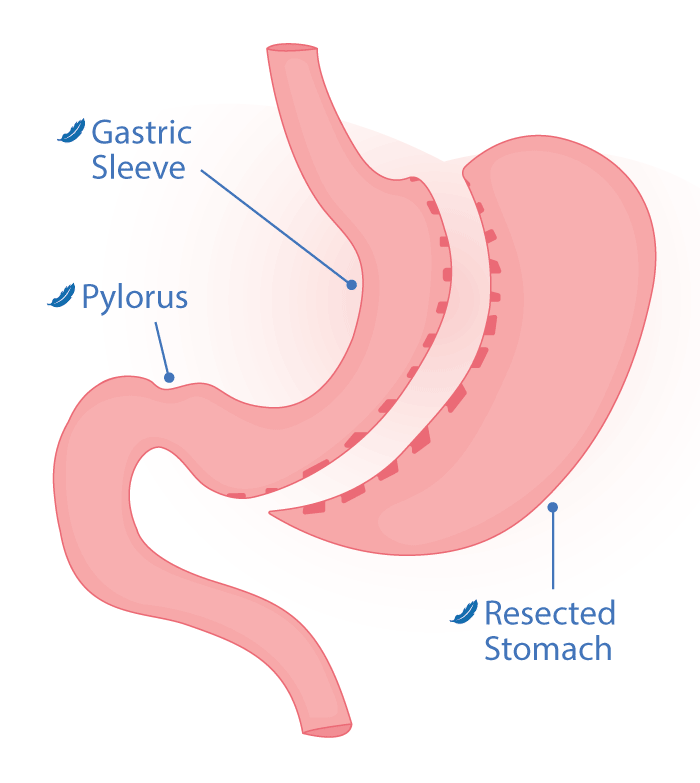GASTRIC SLEEVE
Also known as Vertical Sleeve Gastrectomy

Sleeve Gastrectomy is an effective form of bariatric surgery, suitable for low and high BMI patients who do not suffer from acid reflux (GERD) or strong heartburn (that requires antacids on a regular basis). Also known as Vertical Sleeve Gastrectomy, Vertical Gastroplasty, Sleeve Gastroplasty or VSG, gastric sleeve surgery is a restrictive procedure meaning that it achieves weight loss results by restricting the amount of food that your body is physically able to take in. There is no malabsorption involved with this procedure, but the gastric sleeve surgery can be followed up with a malabsorptive procedure afterwards, such as Mini Gastric Bypass or RNY Gastric Bypass, if a patient wishes and qualifies. To help you determine whether gastric sleeve is the right choice for you, compare it to other bariatric surgeries at Compare Bariatric Surgeries.
It is important to think of gastric sleeve surgery as a tool to help you change your lifestyle permanently. It is not an instant fix. True, any type of weight loss surgery gives our body a hormonal and metabolic boost, promoting fast weight loss at initial post-op stages. It also causes our stomach to control us. However, this so-called honeymoon period in weight loss surgery will not last forever. Eventually, once the stomach is fully healed and can tolerate almost all types of food, the patient needs to take charge. You will still need to eat a healthy diet and get regular exercise. The surgery will help you control your portion size, but not the choices you make. Making the low-carb protein pre-op diet your permanent diet will help you reach your weight goal and maintain it.
DESCRIPTION

SURGERY TIME
On average, the gastric sleeve surgery (the work performed by the surgeon on the stomach itself) lasts from 30 to 45 minutes, or up to 1 hour including preparation time and closing the incisions. Afterwards, patients are taken to the recovery area, where they remain under direct medical observation while recovering from anesthesia for about 1 – 1.5 hours. Lastly, they are taken to their hospital rooms and are reunited with their companions (Please review What to Expect in Tijuana for more details).

HOSPITAL STAY
All types of bariatric surgery require a 2-night stay at the hospital. First day: admission and surgery. Second day: Leak test. Third day: drain tube removal (can also be removed on the 2nd day) and discharge. Your companion is welcome to stay with you, as every hospital room is equipped with a companion`s bed. Please go to New City Hospital and CIBA Surgical Center on this website for more details.

HOW YOU LOSE WEIGHT?
Weight loss will be rapid within the first 3 months post-op and will naturally slow down as you get closer to your goal weight. You will go through multiple plateau stages when scales will show no loss of weight, however body sizes will continue changing. For more details refer to the Post-Op Diet.

HOW MUCH YOU LOSE?
Weight loss after gastric sleeve surgery can be a little slower than after gastric bypass, this differs in every individual case and depends on your age, sex, initial BMI, previous weight loss surgeries if any, thyroid function, level of stress, length of sleep, and many other factors, but mainly on the patient`s aderence to the nutritional guidelines. On average, one should expect to lose at least 50 percent or more of the excess body weight within the first year after surgery. Low BMI patients with starting BMI under 35 can expect to lose all of their excess weight within 8 to 12 months post-op. Usually, final results are achieved by the end of the 2nd year post-op. Success is higher among people who make a permanent lifestyle change that includes not only physical but mental aspects (emotional health, stress control), and are physically active. Our bariatric nutritionists are available before and after surgery in order for you to fully benefit from the procedure and reach your desired weight. We cannot set your goal weight. The weight you are comfortable and happy with, the weight you can maintain is your perfect weight, it can differ for each individual of the same height.

METHOD
Our bariatric surgeons, Dr. Francisco Zavalza and Dr. Cynthia Hernandez, perform gastric sleeve surgery laparoscopically, making 3 to 5 tiny 1/4-to-1/2-inch abdominal incisions.
1. After you receive general anesthesia, an endoscopy will be performed to examine your stomach on the inside and determine whether any conditions are present such as gastritis, esophagitis, Barrett`s esophagus, stomach polyps, etc. Next the surgeon will inflate the abdominal cavity with the CO2 gas, in order to create space around the internal organs.
2. Insert the laparoscope — a tool with a light and a tiny camera that sends pictures to a nearby computer monitor.
3. Remove about three-quarters of your stomach by making a vertical cut with the help of a cauterizing laparoscopic linear stapler.
4. A double staple line is created. Over the staple line, the surgeon hand stitches it in order to decrease postoperative risk of bleeding. The stomach shape changes to a thin tube or “sleeve” (the length of the stomach is preserved, the lower stomach muscle called Pyloric Sphincter is preserved intact, the width of the stomach is decreased).
5. If a hiatal hernia is diagnosed, it will be repaired. A so-called anchor stitch is made only when necessary in order to create a fixed stomach position in the abdominal cavity and prevent possible sliding hiatal hernia. If the patient requested gallbladder removal (cholecystectomy), it will be performed at the same time. Other additional procedures such as tubal ligation or hysterectomy, other types of hernia repair can be combined with the gastric sleeve surgery.
6. The portion of the stomach that is cut off is removed from the abdominal cavity via one of the incisions. A second endoscopy is performed to rule out internal bleeding and staple line disruptions. Abdominal incisions are hand stitched with 100% dissolvable suturing material. Only one abdominal incision is stitched both on the inside and on the outside in order to prevent incisional hernia. The internal stitching is not dissolvable.
7. Surgery video is provided to each patient for your records, and a photo of the removed stomach portion is available upon request.

SURGICAL INSTRUMENTS
Our medical team uses only well-known brands such as Covidien made in the USA, Echelon, made in the USA by Johnson & Johnson, and Waston Medical, a well-known China-based manufacturer that is FDA approved in Latin America, Europe, Africa, Asia and Australia for its high quality. All staples are Titanium, they do not interfere with MRI, CT scan or airport metal detectors. The staples remain inside on the patient`s body for the rest of their life without causing any discomfort. The suturing materials used are hypoallergenic, some are 100% dissolvable, others do not dissolve (such as internal stitches).

RECOVERY TIME
Since the gastric sleeve surgery is done laparoscopically, recovery time is much shorter compared to an open surgery. Depending on the type of job you have, our recommendations are:
1. For a sedentary type of work – at least 7 to 10 days off.
2. If your job requires strenuous physical activity (nurses, truck drivers, policemen, etc.) and lifting anything heavier than 15 pounds, we recommend at least 2-3 weeks off. The weight lifting restrictions are: up to 15 pounds for 2-3 weeks post-op, and up to 35 pounds for another 2-3 weeks. After 6 weeks you may go back to normal weight lifting but gradually.
3. Keep in mind that due to a low-calorie diet you will feel very weak and lack energy, and get easily tired during the first 4 to 6 weeks post-op. So, it may be difficult to concentrate on work (mental or physical) during this time until your body adjusts and your diet progresses to the point where you can tolerate a greater variety of foods and more calories.
HOW IT DIFFERS FROM GASTRIC BYPASS?
